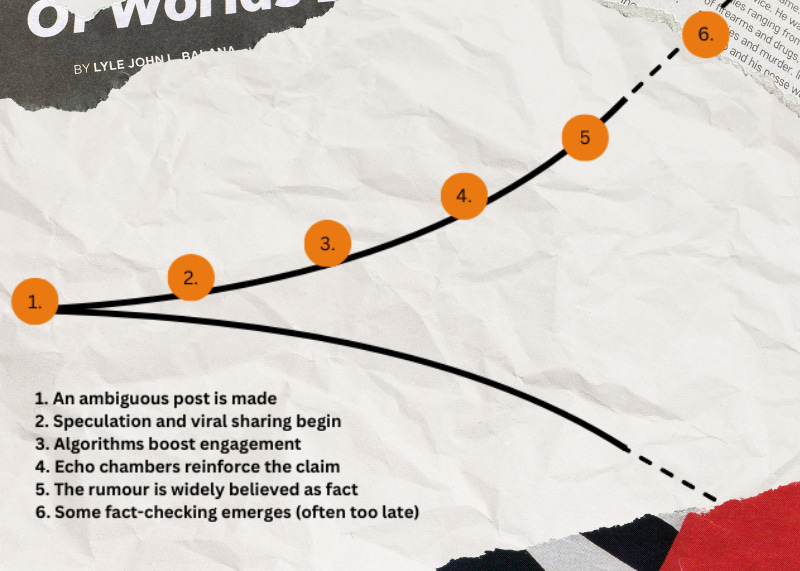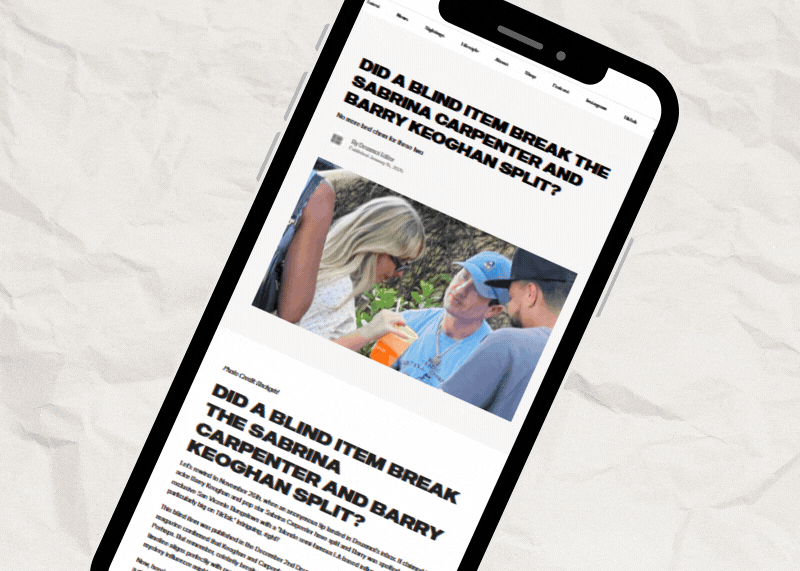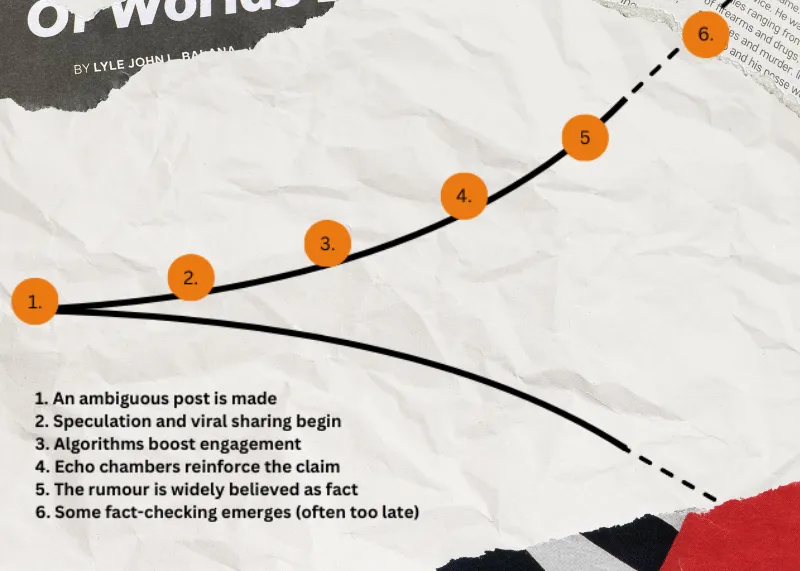Mapping the lifecycle of online speculation and uncovering how fleeting gossip gains global reach
A single off-hand comment in a Reddit forum or a seconds-long video clip on TikTok can blossom into a rumour with millions of believers. Modern social media platforms allow small-level gossip to travel at high speed, turning passing commentary into a ‘breaking story’ within hours. The previous piece introduced how people can form strong opinions based on questionable evidence – illustrated by the Selena Gomez–Hailey Bieber ‘feud’ or the Gracie Abrams / Paul Mescal breakup at Jolene’s. This part delves deeper into the mechanics of rumour-building, aiming to showing the stages by which a remark or a ‘story’ shared on Deuxmoi can become the top headline in newspapers and websites around the world.
Although rumours are hardly a new phenomenon, the interconnectedness of social networks has transformed their lifecycle. A casual observer might believe a viral rumour has always been ‘common knowledge,’ when in reality it reached mass visibility through a series of predictable steps.
By following the path from spark to global trend, you may gain a clearer view of how widespread misconceptions take shape. Because so did I, and it helped me go through the stages of checking myself on why I had a certain opinion, why I wanted a certain product and so on.

The Spark: Seeds of speculation
Every rumour begins with a ✨spark✨ a tiny piece of content or commentary that might be harmless in isolation. This could be a snippet from a livestream, a passing headline in a small publication, or a user-generated post mentioning a celebrity sighting or as much as a comment on one of the above. Sometimes, a ✨spark✨ is deliberately planted by individuals with hidden agendas. But more often, it emerges spontaneously. Perhaps a person casually mentions seeing a celebrity at a certain venue under suspicious circumstances and submits it to DeuxMoi, or a X/Twitter poster shares their thoughts about local events without citing a credible source.
At this stage, the information lives only in a small corner of the internet. It might remain there indefinitely if nobody reacts. However, it possesses the potential to move into a second, more powerful phase once the spark resonates emotionally with a particular audience. Curiosity, outrage, or excitement can all motivate readers to share or comment, advancing the content beyond its original confines.
The key risk here is the lack of initial verification and emotion involved. Early consumers of the spark may accept it at face value – especially if it aligns with their existing beliefs – thereby setting the stage for rapid growth.
Local Sharing: Building momentum within communities
After the ✨spark✨ appears, it often circulates within a small community – perhaps a specific TikTok creator’s videos, a fandom-driven Twitter list, or a niche Subreddit. In this stage, personal interpretation and speculation dominate, as enthusiastic group members embellish the rumour with their own comments, theories, or personal anecdotes. Fact-checking is usually minimal; excitement, shock, or groupthink guide the conversation.
For example, if the rumour revolves around a musician, fans might be the first to pick it up, discussing implications for the artist’s next album. Gossip blogs or fan-run social accounts may amplify the story, adding speculative layers that shape public perception. This insular, local sharing is the backbone of rumour propagation: it forges an initial sense of urgency or importance.
The key risk here is Groupthink. And this can be so fun – right, like think off trying to guessing the right easter eggs about the next Taylor Swift album, together you may get closer towards solving it right? Well members of tight-knit communities often avoid challenging the rumour. Instead, they reinforce one another’s assumptions, embedding the story firmly in the group’s shared consciousness.
Algorithmic Boost: The fuel of virality
Modern social media platforms rely on algorithms that highlight content with high engagement (shares, likes, comments, watch time). This algorithmic framework can catapult a rumour from a small circle to millions of users worldwide. Because platforms favour posts that trigger strong reactions – anger (Instagram!), excitement, or even hilarity – sensational or provocative content finds a ready audience. If you look at Twitter’s (I will refuse to call it anything else from here onwards..) For You feed, you will have realised it mostly consists of what opinion Twitter (Elon Musk) wants to enforce – conspiracy theories about plane crashes and who caused them, war videos (that when checked aren’t actually current) and so forth. This one tends to be more on the nose…
A TikTok video speculating about a scandal, for instance, might be boosted if viewers leave an above-average number of comments, propelling it onto more feeds. Twitter might feature a trending hashtag in its ‘Search’ but curated topics section, prompting curious onlookers to click and learn more – often accepting the hype without deeper scrutiny.
The key risks here are echo chambers. Those who interact with the rumour receive even more related content, intensifying confirmation bias and the rumour’s perceived credibility.
Mainstream Adoption: When gossip becomes ‘news’
Following significant social media traction, rumours may attract the attention of mainstream media outlets or creators searching for trending topics with the aim of winning views . Even reputable news organisations occasionally report on a viral claim because it is ‘what people are talking about,’ although coverage styles vary from sceptical to sensational, and just plain clickbait (Facebook I’m looking at you). Mainstream adoption often cements the rumour’s perceived credibility. Audiences who trust major publications may assume a story is true if many outlets report it.
Moreover, businesses or public figures at the centre of the rumour may issue press releases to ‘clarify matters,’ unintentionally prolonging the news cycle. In some cases, celebrities directly address rumours, generating further headlines. The narrative shifts from a fringe conversation to a matter of public record.
The key risk here is false equivalence. Some media outlets may present a rumour alongside legitimate information without clearly distinguishing verified facts from speculation, giving undue weight to a baseless claim.
Viral Peak: Collective obsession
At its highest point, a rumour saturates news feeds and trending topics. Trending hashtags show up on multiple platforms; reaction videos proliferate; pundits debate the topic on talk shows. People who have no prior interest might suddenly join the conversation because it is omnipresent.
It make even make them money. This one is actually a key aspect to be aware of; does driving viewership on this particular topic make the sharer money. And this can come from various places – TikTok creators that are part of the Creator Rewards program for example get paid only for videos 1 minute plus, that is when they become eligible for payouts, some fringe media outlets will make money from placing advertising alongside articles, the more clicks onto their website the more traffic to potentially drive clicks into other areas.
But even moreso for the public, this immersion reinforces the narrative that the rumour must be legitimate, simply by virtue of widespread discussion.
During this stage, businesses, marketers, or creators may seize further opportunities to capitalise on the rumour’s momentum. Memes, merchandise, or spin-off hashtags appear, pushing the claim further into public awareness. Often, any quest for factual accuracy is sidelined by the attention-grabbing novelty of the story with the aim of benefiting from it.
The key risk here is overload and sensationalism. The frenzy around a rumour can drown out trustworthy sources. Readers may find it difficult to locate reliable information in a flood of memes and speculation.
Debunking or Decline: The aftermath
Eventually, more thorough investigations may emerge. Private communications surface, contradictory evidence appears, or reputable voices step forward to challenge the rumour. Sometimes, official statements or legal actions prompt a re-evaluation of the narrative. The rumour either crumbles under scrutiny or persists among die-hard supporters.
However, rumours often leave a persistent trace in the public mind. The illusory truth effect – where repeated statements, even if debunked, retain influence – ensures that a seed of the rumour remains, even after most people have moved on.
The key risk here is residual belief. Those who initially embraced the rumour might hold onto fragments of it, eroding trust in debunking efforts or official clarifications.
The rumour mill follows a predictable pattern: spark, local sharing, algorithmic boost, mainstream adoption, viral peak, then debunking or decline. Recognising these stages can help you as the audience identify when to question claims. And take stock into who is benefiting of it, sometimes it may just be likes on a comment, sometimes it maybe about being the fuel for the fire and sometimes it maybe about reframing public opinion about a topic and its benefitor.
Understanding emotional triggers, algorithmic incentives, and group dynamics can also mitigate the impact of fast-moving, unverified gossip.
Better media literacy and a willingness to investigate sources can slow the pace of rumour proliferation. Still, the digital landscape remains fertile ground for viral speculation. The upcoming article will dive into the psychological and technological underpinnings that make rumours so captivating and persistent – factors that, once understood, can help readers maintain a more sceptical, informed approach.

References & Further Reading (Part 2)
- Vosoughi, S., Roy, D., & Aral, S. (2018). The spread of true and false news online. Science, 359(6380), 1146–1151.
- Wardle, C., & Derakhshan, H. (2017). Information Disorder: Toward an interdisciplinary framework for research and policymaking. Council of Europe.
- UNESCO. (2020). Journalism, ‘Fake News’ & Disinformation: A Handbook for Journalism Education and Training.
- Tandoc, E. C., Jenkins, J., & Craft, S. (2019). Fake news as a critical incident in journalism. Journalism Practice, 13(6), 673–689.



